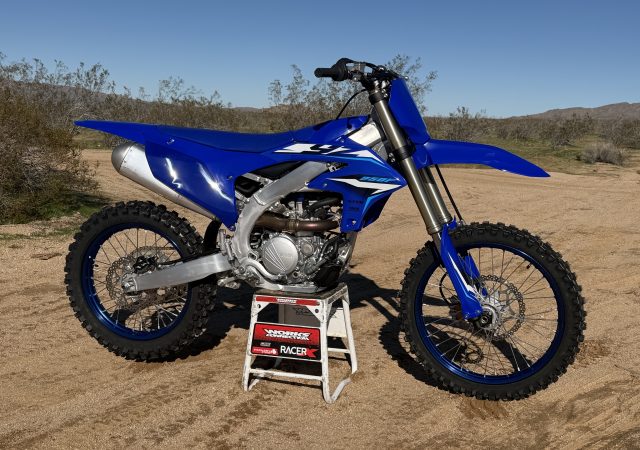
For this edition of Classic Steel, we are going to take a look back at Kawasaki’s all-new 2006 KX250F.
 All-new from the ground up, the 2006 KX250F was Kawasaki’s first attempt at a 100% green 250 four-stroke motocross machine. Photo Credit: Kawasaki
All-new from the ground up, the 2006 KX250F was Kawasaki’s first attempt at a 100% green 250 four-stroke motocross machine. Photo Credit: Kawasaki
The 2004 season was a great time to be a four-stroke motocross enthusiast. That year, the YZ250F finally got a bit of competition with the introduction of Honda’s first CRF250R and a pair of four-strokes from Kawasaki and Suzuki. The all-new KX250F and RM-Z250 were the result of a marriage of convenience between Kawasaki and Suzuki. The incredible success of Yamaha’s original YZ400F and subsequent YZ250F had taken the rest of the motocross world by surprise and left the other Big Four manufacturers scrambling to catch up. Even with Honda’s near limitless resources, it took Big Red four years to come up with a competitor to the YZ400/426F. For Kawasaki and Suzuki, that mad scramble to come up with a YZF competitor had been even more daunting and in 2001 the two manufactures decided to pool their resources. This new Kawasaki and Suzuki alliance would allow both manufacturers to fill out their lineups with rebadged versions of the other’s products and help speed up the development of a YZF competitor.
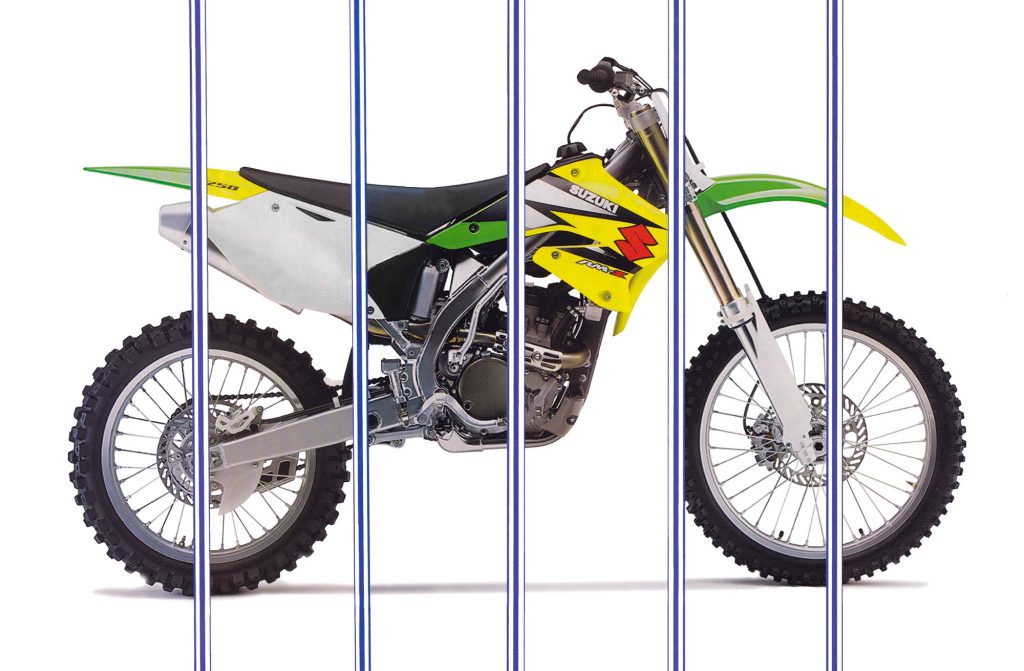 The first-generation KX250F/RM-Z250 was a unique combination of Kawasaki and Suzuki engineering that never quite gelled to perfection. Photo Credit: Motocross Action
The first-generation KX250F/RM-Z250 was a unique combination of Kawasaki and Suzuki engineering that never quite gelled to perfection. Photo Credit: Motocross Action
In 2004, the fruit of this marriage made its debut in the form of the all-new Kawasaki KX250F and Suzuki RM-Z250. Manufactured by Kawasaki with a KX-derived chassis and Suzuki-designed motor, the “Kawazuki” twins were competitive, but somewhat controversial. On the track, they proved quite successful with Pro Circuit delivering the 2004 West Coast 125 Supercross title with Ivan Tedesco aboard. In 2005, they were even more successful, with the KX250F delivering both regional 125 Supercross titles and the 2005 125 AMA National Motocross title. With Pro Circuit’s engineering know-how the KX250F was a world beater, but in stock form, it was still a bit of a work in progress.
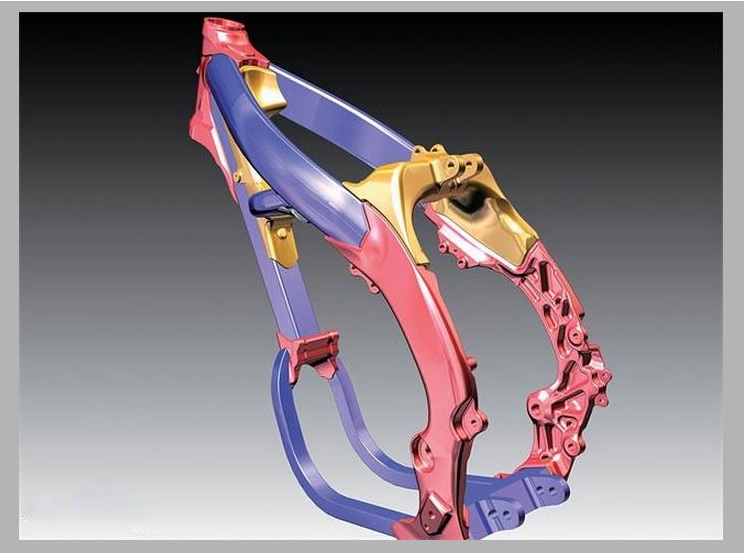 After experimenting with several different frame designs in Japan, Kawasaki settled on an aluminum twin-spar perimeter design very similar in appearance to the one found on Honda’s CRF250R for their second-generation 250F. The new frame was 2.2 pounds lighter than the steel unit employed in 2005 and featured a combination of forged, cast, and extruded aluminum sections to optimize the new frame’s strength and flex characteristics. Photo Credit: Kawasaki
After experimenting with several different frame designs in Japan, Kawasaki settled on an aluminum twin-spar perimeter design very similar in appearance to the one found on Honda’s CRF250R for their second-generation 250F. The new frame was 2.2 pounds lighter than the steel unit employed in 2005 and featured a combination of forged, cast, and extruded aluminum sections to optimize the new frame’s strength and flex characteristics. Photo Credit: Kawasaki
Most riders liked the Kawazuki twin’s motor with its strong low-to-mid power, but both machines were beset with a myriad of reliability issues. Overheating was a constant concern and the valvetrain proved prone to failures. There were also issues with the transmission and clutch if the twins were ridden aggressively, and the chassis was also somewhat polarizing for riders expecting a Suzuki level of handling precision. Despite the yellow plastic and large “S” emblazoned on the radiator shroud, the RM-Z felt 100% Kawasaki on the track. There was none of the light, lithe feel and sharp handling riders had come to associate with the RM two-strokes. Instead, the twins offered a middle-of-the-road handling package that was slightly unbalanced but serviceable with some chassis tuning.
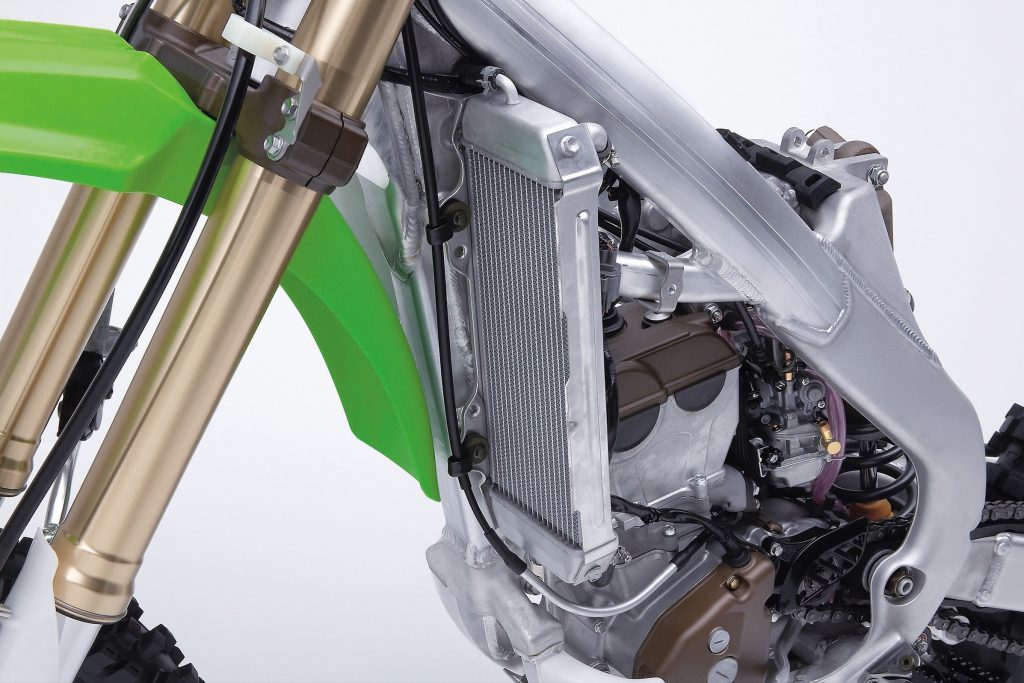 All-new radiators for 2006 offered increased capacity and redesigned cores for improved cooling and a narrower profile. Photo Credit: Kawasaki
All-new radiators for 2006 offered increased capacity and redesigned cores for improved cooling and a narrower profile. Photo Credit: Kawasaki
In the end, the lesson that both manufactures took away from the alliance was that it was not an ideal situation for either. It did allow them to get a 250F to market quickly, but the odd combination of Kawasaki and Suzuki design elements and performance philosophies never quite gelled into the machine both teams had hoped for. By 2005, both manufacturers had concluded that their strategic alliance was not delivering the expected engineering and sales success they had hoped for. Moving forward, it was decided that by 2007, Kawasaki and Suzuki would pare down their lineups and stop selling rebadged versions of each other’s machines.
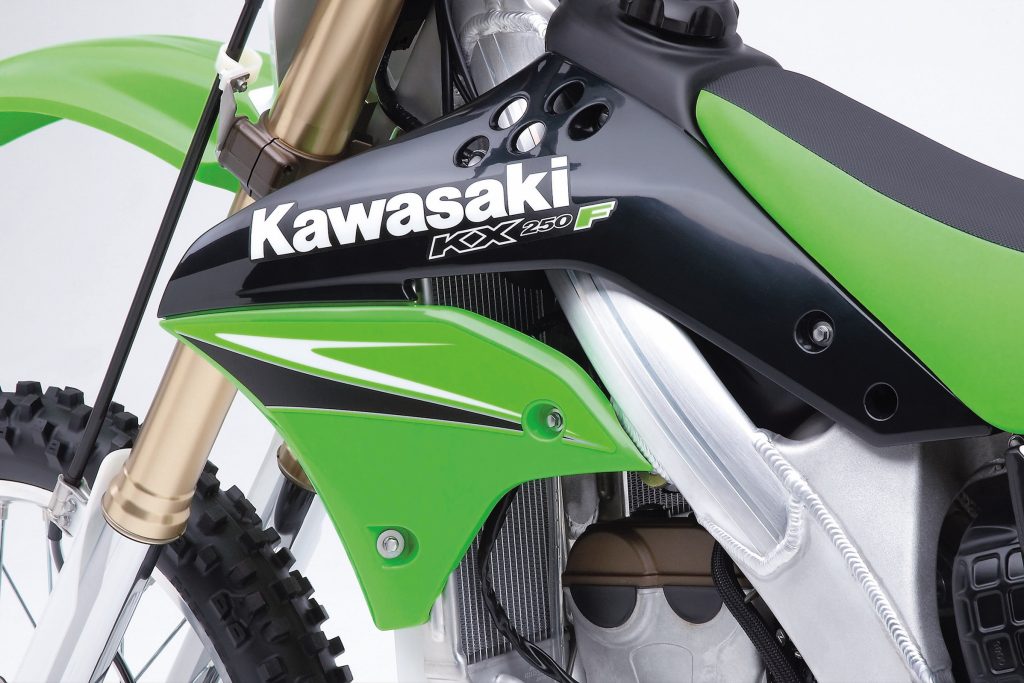 All-new bodywork featured unique two-piece radiator shrouds with vent holes incorporated to aid cooling. Photo Credit: Kawasaki
All-new bodywork featured unique two-piece radiator shrouds with vent holes incorporated to aid cooling. Photo Credit: Kawasaki
On the motocross front, this meant the second generations of the KX250F and RM-Z250 would be wholly unique machines. In this respect, Kawasaki had a bit of a head start with their redesigned KX250F set to debut in 2006. Suzuki, on the other hand, had devoted most of their design resources toward developing their all-new RM-Z450, so their new 250F would have to wait until the 2007 model year to make its debut.
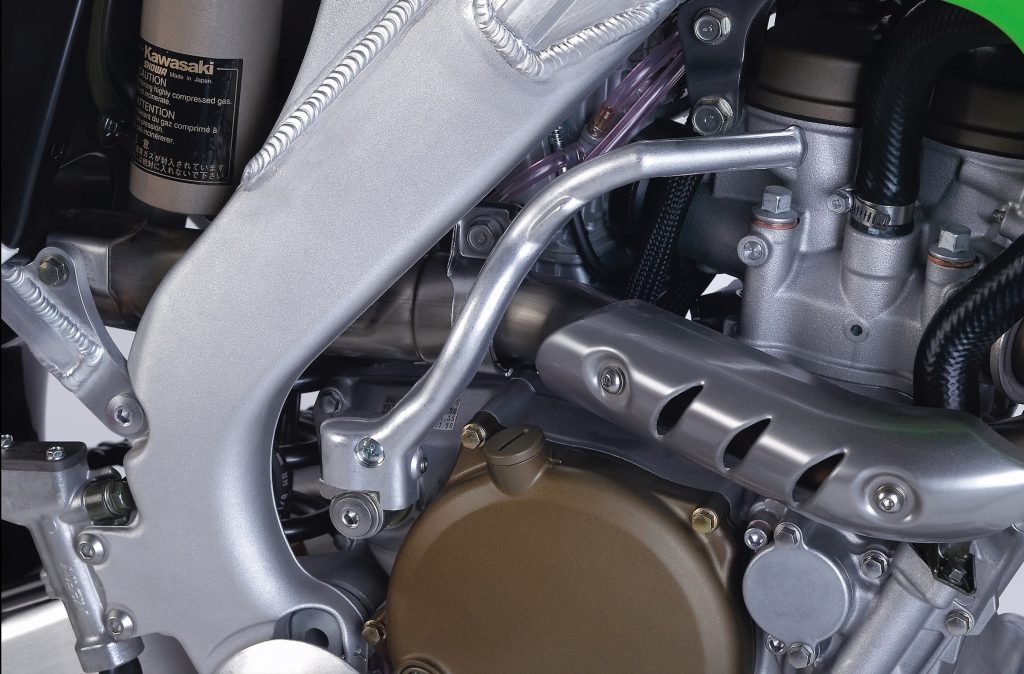 Changes made to the motor, ignition, and carburetor for 2006 helped make the new KX250F one of the easiest starters in the class. Photo Credit: Kawasaki
Changes made to the motor, ignition, and carburetor for 2006 helped make the new KX250F one of the easiest starters in the class. Photo Credit: Kawasaki
Now unconstrained by their affiliation with Suzuki, Kawasaki set about making a much improved and fully “Kawasaki” KX250F for 2006. For the second generation of their 250F, Kawasaki decided to move away from the steel perimeter chassis design they had been employing since 1990. During prototype testing, Kawasaki had experimented with several different variations on an alloy chassis design, but in the end, they decided to stick with a proven perimeter configuration that bore more than a passing resemblance to the one found on Honda’s CRF line of machines. The new chassis was crafted out of a combination of forged, cast, and extruded aluminum parts and was designed to reduce weight, increase flex resistance, improve chassis balance, and provide superior traction under power. The new frame featured 27.5 degrees of rake and 4.7 inches of trail, and a slightly wider profile at the footpegs to provide additional rider control. The new frame was both stiffer and lighter, shaving 2.2 pounds of weight from the 2005 chassis.
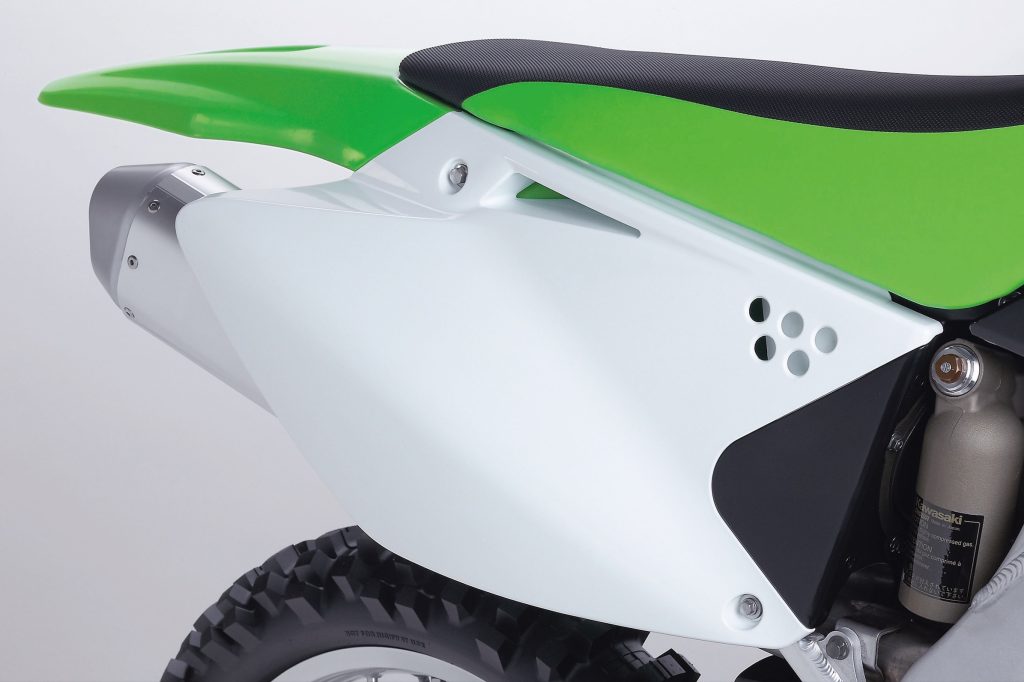 The KX’s new bodywork was handsome and functional with handholds and vent holes built into the side plates to improve engine breathing and make lifting the machine easier. As an additional unexpected benefit, aftermarket exhausts for the 2005 KX250F were designed to bolt directly onto the new 2006. Photo Credit: Kawasaki
The KX’s new bodywork was handsome and functional with handholds and vent holes built into the side plates to improve engine breathing and make lifting the machine easier. As an additional unexpected benefit, aftermarket exhausts for the 2005 KX250F were designed to bolt directly onto the new 2006. Photo Credit: Kawasaki
In addition to the new frame, Kawasaki made the surprising move to switch suspension suppliers from their long-time partner Kayaba to Showa. This was a first for the KX, but Kawasaki did hedge their bets by keeping the all-new KX450F on Kayaba for 2006. Up front, the new KX250F employed a 47mm version of Showa’s latest Twin-Chamber cartridge design. By separating the oil and air into individual chambers, the Showa Twin-Chamber fork reduced oil degradation and provided smoother and more consistent damping. Overall travel was set at 12.4 inches with 16 selectable settings for compression and rebound control.
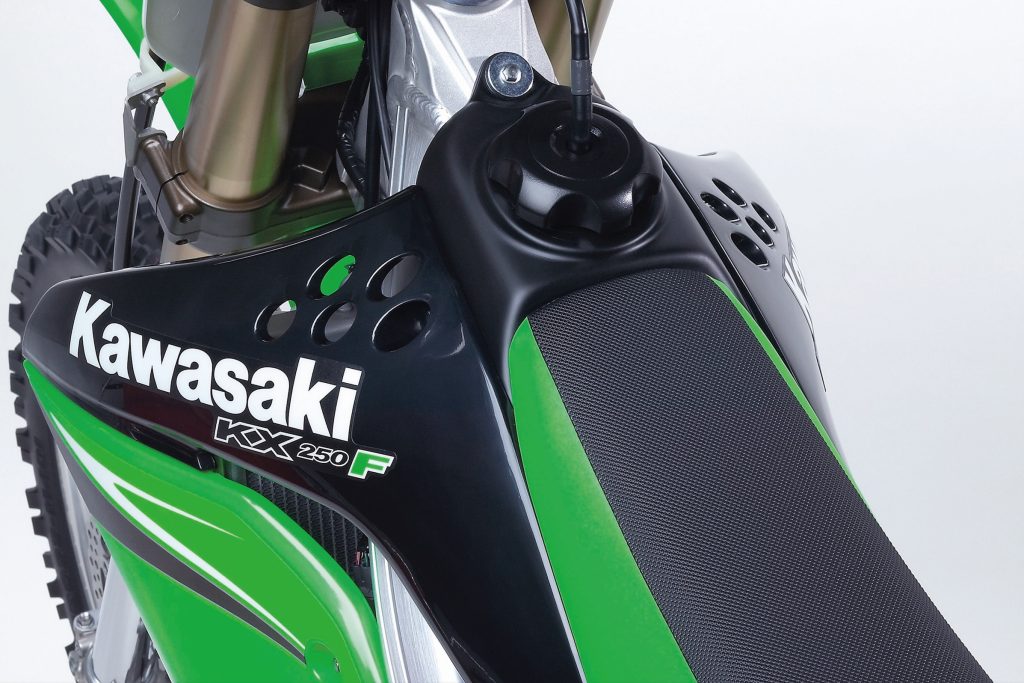 The KX’s pilot compartment was very slim and one of the most comfortable in the class in 2006. Photo Credit: Kawasaki
The KX’s pilot compartment was very slim and one of the most comfortable in the class in 2006. Photo Credit: Kawasaki
Out back, the KX250F employed an all-new Showa shock and redesigned UNI-TRAK linkage. The new shock featured 12.4 inches of travel as well as separate adjustments for high and low-speed compression control and 17 selectable settings for rebound damping. The new shock and linkage sat lower on the chassis for 2006 and were designed to provide better tracking in the rough and superior traction under acceleration. The new swingarm was stronger for 2006 and no longer painted so ugly black scratches would be a thing of the past. All-new wheels reduced weight by shaving down the hubs and reducing the number of spokes by one. Redesigned rotors moved to a “wave” design that reduced weight, looked great, and improved cooling and cleaning in the mud. Finally, all-new Renthal aluminum bars for 2006 offered a revised bend, increased comfort, and upgraded durability from the cheap steel bars found on the KX250F in 2005.
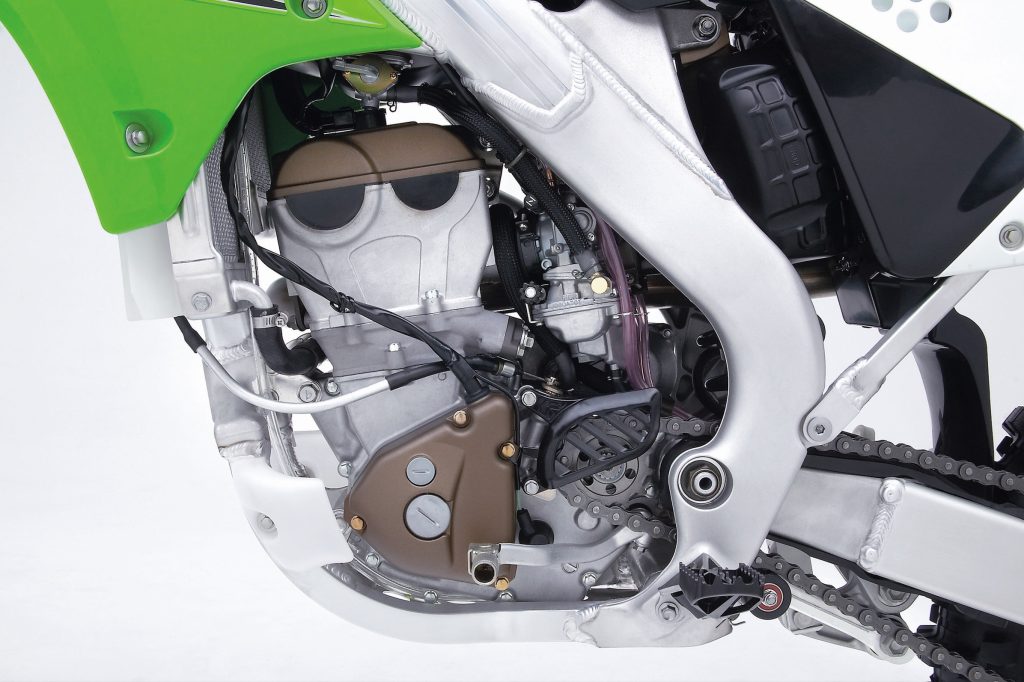 Significant motor upgrades for 2006 included new cams, upgraded valves, a redesigned piston, revamped ignition, beefed up clutch, strengthened transmission, and a more efficient oiling system. Photo Credit: Kawasaki
Significant motor upgrades for 2006 included new cams, upgraded valves, a redesigned piston, revamped ignition, beefed up clutch, strengthened transmission, and a more efficient oiling system. Photo Credit: Kawasaki
On the motor front the KX250F was upgraded but not as transformed as the rest of the machine for 2006. The 249cc DOHC mill maintained the same configuration it had employed since 2004 but added several enhancements aimed at increasing power and improving reliability. The top end featured new porting, a revised cam, stiffer valve springs, upgraded valve seats, and a new piston with small oil channels to improve lubrication. These changes increased compression from 12.6:1 to 13.5:1 for 2006. The crank was surface hardened to improve durability and the oil pump was upgraded to flow 20% more oil than in 2005. New radiators for 2006 featured more capacity and a redesigned core for improved cooling and a slimmer profile. Additional holes in the airbox and a redesigned intake improved breathing and an all-new digital ignition with Throttle Position Sensor (TPS) provided a hotter spark and higher rev ceiling for 2006. As in 2005, the ubiquitous Keihin FCR37 carburetor handled the mixing duties on the green machine. An all-new exhaust maintained the titanium head pipe of 2005 and featured a freer-flowing muffler for improved power.
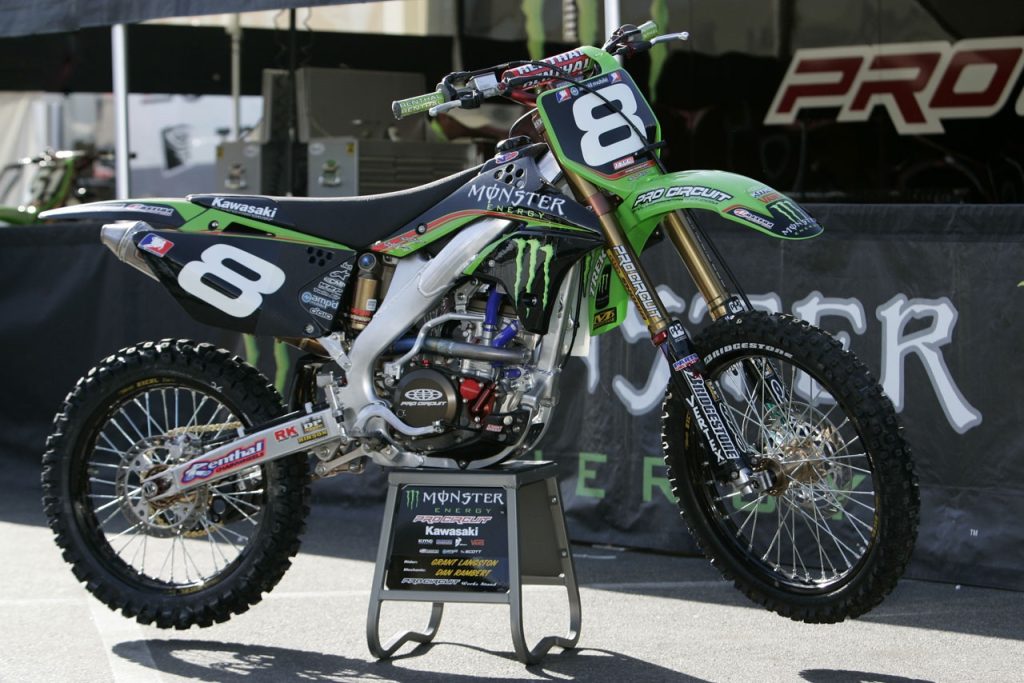 With the departure of two-time 125 Supercross champ Ivan Tedesco to Suzuki, Pro Circuit’s hopes in the Supercross Lites division fell to multi-time champion Grant Langston and rookie Ryan Villopoto. Photo Credit: Transworld Motocross
With the departure of two-time 125 Supercross champ Ivan Tedesco to Suzuki, Pro Circuit’s hopes in the Supercross Lites division fell to multi-time champion Grant Langston and rookie Ryan Villopoto. Photo Credit: Transworld Motocross
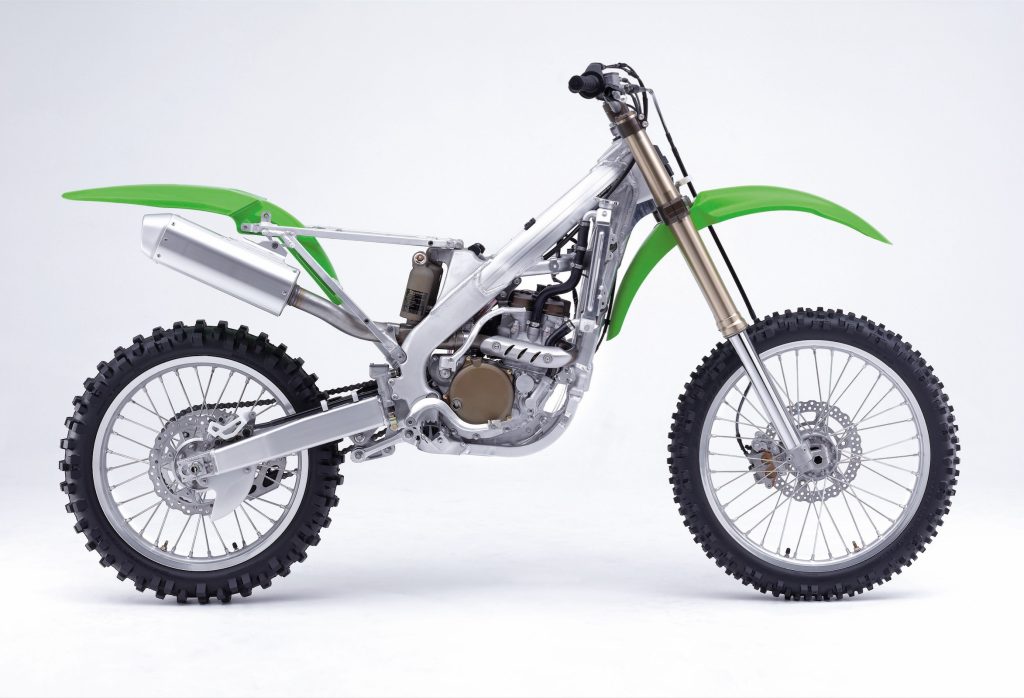 In addition to the redesigned frame the 2006 KX250F featured all-new Showa suspension components front and rear. Photo Credit: Kawasaki
In addition to the redesigned frame the 2006 KX250F featured all-new Showa suspension components front and rear. Photo Credit: Kawasaki
Clutch and transmission failures were a hallmark of the first-generation KX250F/RM-Z250 so Kawasaki made several changes for 2006 to alleviate these concerns. First up was an all-new clutch that featured redesigned fiber plates and stiffer springs for improved durability. The transmission remained a 5-speed, but upgrades were made to the shift dogs and shift drum in the “ratchet style” shift mechanism to improve shifting feel and durability.
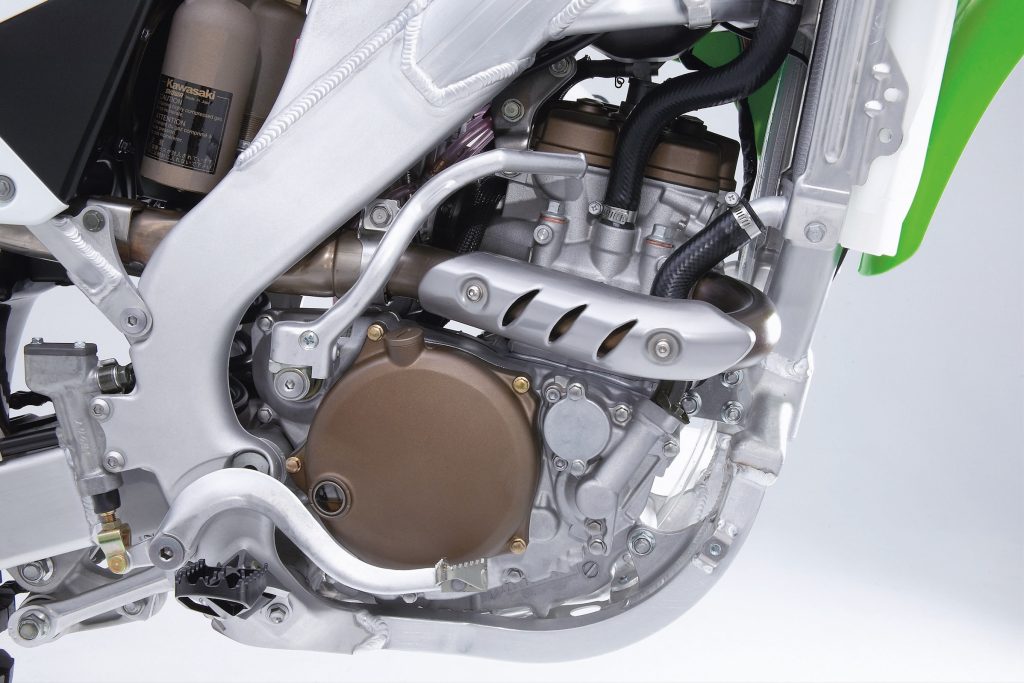 The KX250F’s revamped 249cc DOHC mill featured a strong low-to-mid burst that rocketed the green machine out of corners. Top end power was improved, but the KXF’s powerband was more effective if the machine was shifted rather than bounced off the rev limiter. Photo Credit: Kawasaki
The KX250F’s revamped 249cc DOHC mill featured a strong low-to-mid burst that rocketed the green machine out of corners. Top end power was improved, but the KXF’s powerband was more effective if the machine was shifted rather than bounced off the rev limiter. Photo Credit: Kawasaki
Visually, the 2006 KX250F was all-new with redesigned bodywork and a sleeker rider compartment. New two-piece radiator shrouds incorporated vent holes to improve engine cooling and offered a very narrow profile to increase rider comfort. The new seat was flatter on top to aid rider movement and new side plates featured vent holes to increase airflow to the new airbox. The front fender remained unchanged, but an all-new rear fender design further updated the KX’s styling. All-new clamps and several engine components featured a trick bronze Cerakote look that gave the new machine a very “works” appearance. These features, combined with the new alloy frame, improved the KX’s overall looks quite a bit in the minds of most testers. If you didn’t mind green, the new KX was easily one of the best-looking machines of 2006.
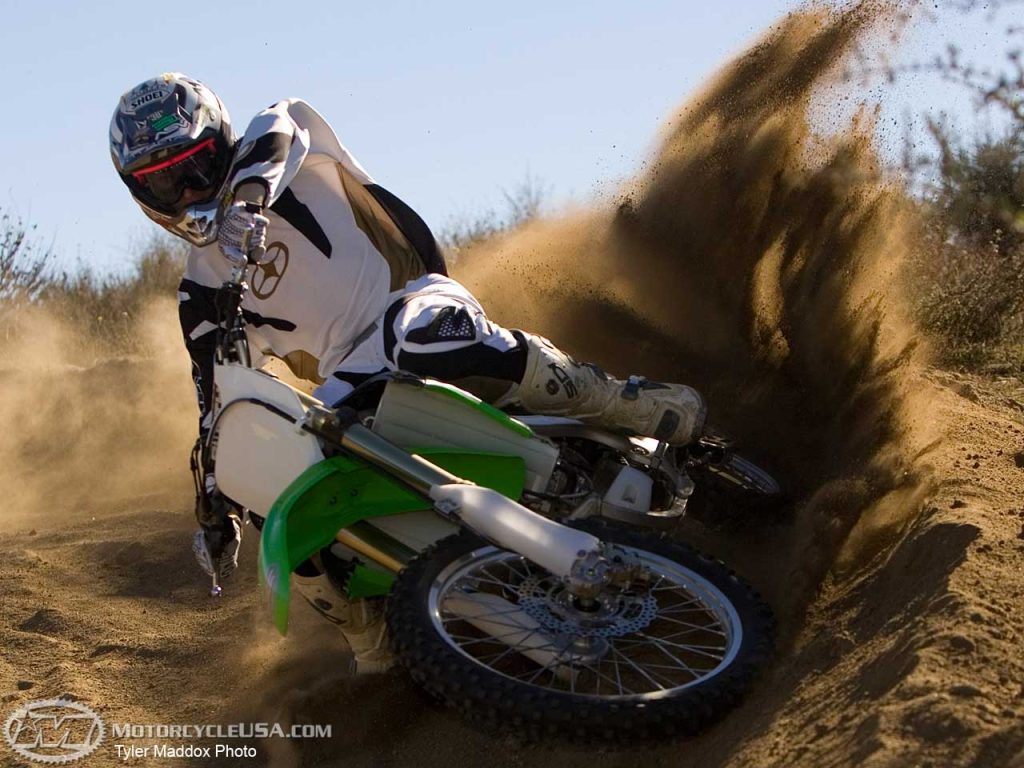 The new KX250F proved to be a much more adept handler than the previous generation machine. Turning was excellent with the KX delivering a light feel and admirable stability. Photo Credit: Tyler Maddox
The new KX250F proved to be a much more adept handler than the previous generation machine. Turning was excellent with the KX delivering a light feel and admirable stability. Photo Credit: Tyler Maddox
On the track, the KX250F was a completely new machine in 2006. The revamped motor started much easier and ran much stronger from bottom to top. Low-to-mid power was excellent and the KX pulled well off the bottom into a hard-hitting midrange blast. The new motor was so potent in the midrange that some testers even compared its feel to that of a 250 two-stroke. Top end power was improved as well but the KX remained less of a rev-ranger than machines like KTM’s 250 SX-F. Relying on its strong low-to-mid thrust was more effective than bouncing it off the rev limiter and it was best to shift the KX rather than scream it until the valves floated. Regardless of how you rode it, however, the KX was plenty fast and more than capable of keeping up with any of its 250F rivals.
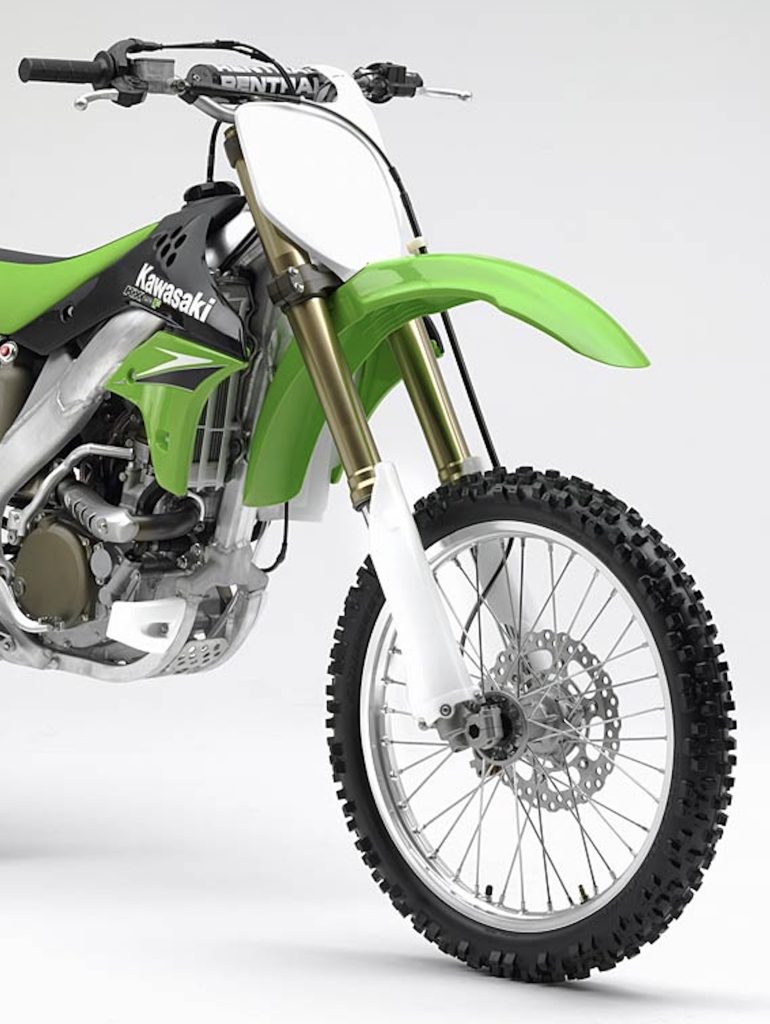 The new 47mm Showa Twin Chamber forks proved to be an excellent addition to the new KX250F. Relatively plush and well damped, they were rated as some of the best forks available in the class in 2006. Photo Credit: Kawasaki
The new 47mm Showa Twin Chamber forks proved to be an excellent addition to the new KX250F. Relatively plush and well damped, they were rated as some of the best forks available in the class in 2006. Photo Credit: Kawasaki
While the new motor was fast, the KX’s clutch and transmission remained less refined than some of its rivals. Shifting feel was good, but the transmission was known to hit a false neutral from time to time. Nothing broke and the transmission proved far more durable than in the past, but it was important to shift with authority to assure the next cog engaged fully. The new clutch was more durable for 2006 but it would fade if abused. Hammer it mercilessly, and the lever would go away as the stock components gave up the ghost. For true throttle jockeys, a Hinson basket and stiffer springs were a good investment.
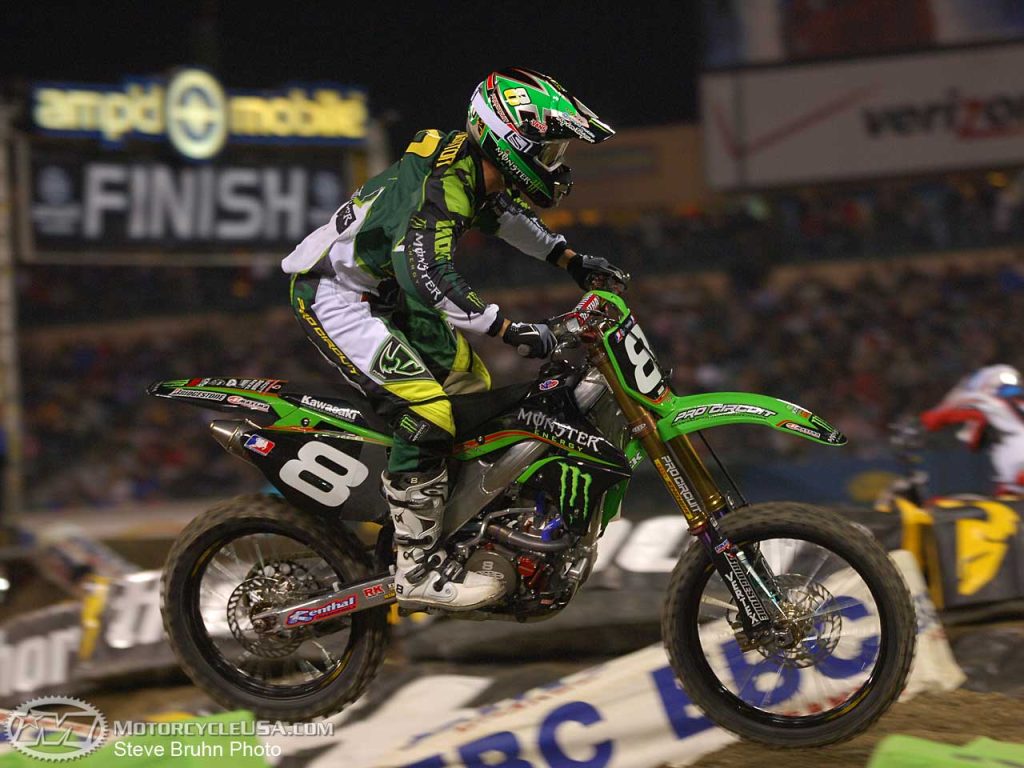 Grant Langston piloted the all-new KX250F to his second 125/Lites Western Region Supercross crown in 2006. Photo Credit Steve Bruhn
Grant Langston piloted the all-new KX250F to his second 125/Lites Western Region Supercross crown in 2006. Photo Credit Steve Bruhn
 The redesigned UNI-TRAK and new Showa damper provided the 2006 KX250F with a much more balanced and well-sorted ride. Photo Credit: Kawasaki
The redesigned UNI-TRAK and new Showa damper provided the 2006 KX250F with a much more balanced and well-sorted ride. Photo Credit: Kawasaki
On the suspension front, the switch to Showa proved to be a successful one. The new Twin-Chamber forks performed excellently, and every tester felt they were an improvement over the Kayaba units used in 2005. The spring rates and damping settings were spot on for most riders below the pro class with the KX delivering good bottoming resistance and a plush feel. Most riders still rated them below the Yamaha’s incredible new SSS Kayaba forks for comfort, but the margin was far from massive between the two.
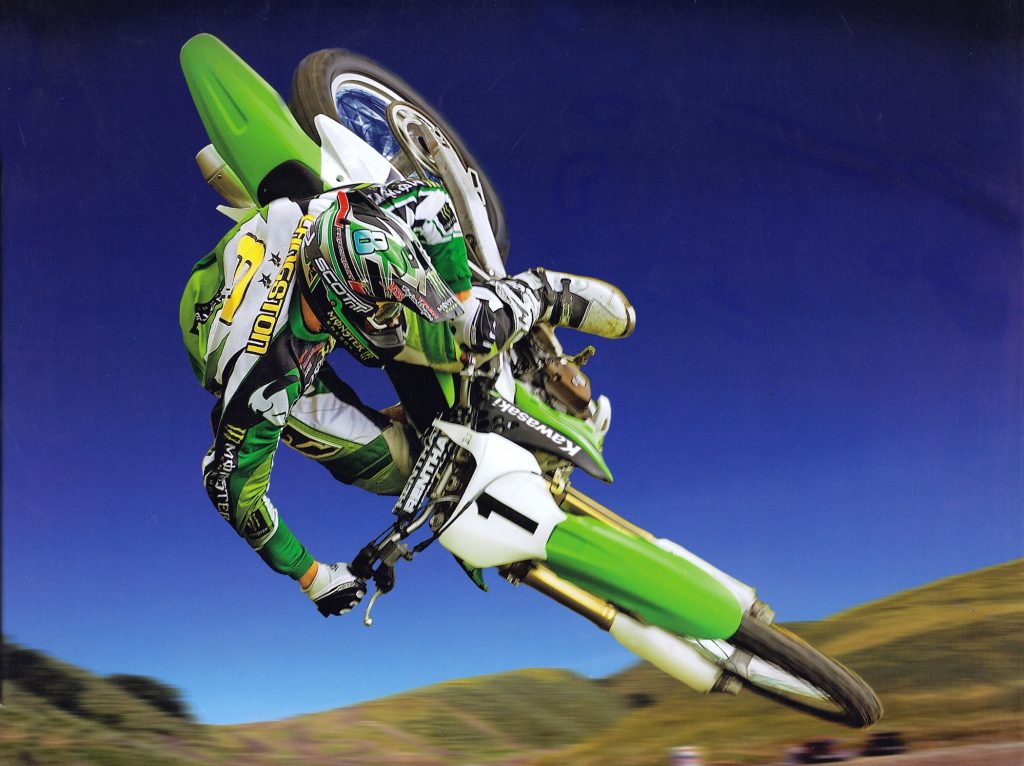 With a talented rider like Grant Langston on board the 2006 KX250F was capable of some pretty spectacular maneuvers. Photo Credit: Kawasaki
With a talented rider like Grant Langston on board the 2006 KX250F was capable of some pretty spectacular maneuvers. Photo Credit: Kawasaki
Out back the all-new Showa shock and UNI-TRAK linkage provided an equally excellent ride. It was a bit stiff for putting around but as long as you were pushing the rear suspension worked very well. Riders of all skill levels seemed to be able to find acceptable settings with only a few adjustments of the clickers. Big hits and small were taken in stride and the shock hooked up and followed the terrain much better than in 2005. Once again, it was only the ultra-plush YZ250F that rated higher in the shock standings of 2006.
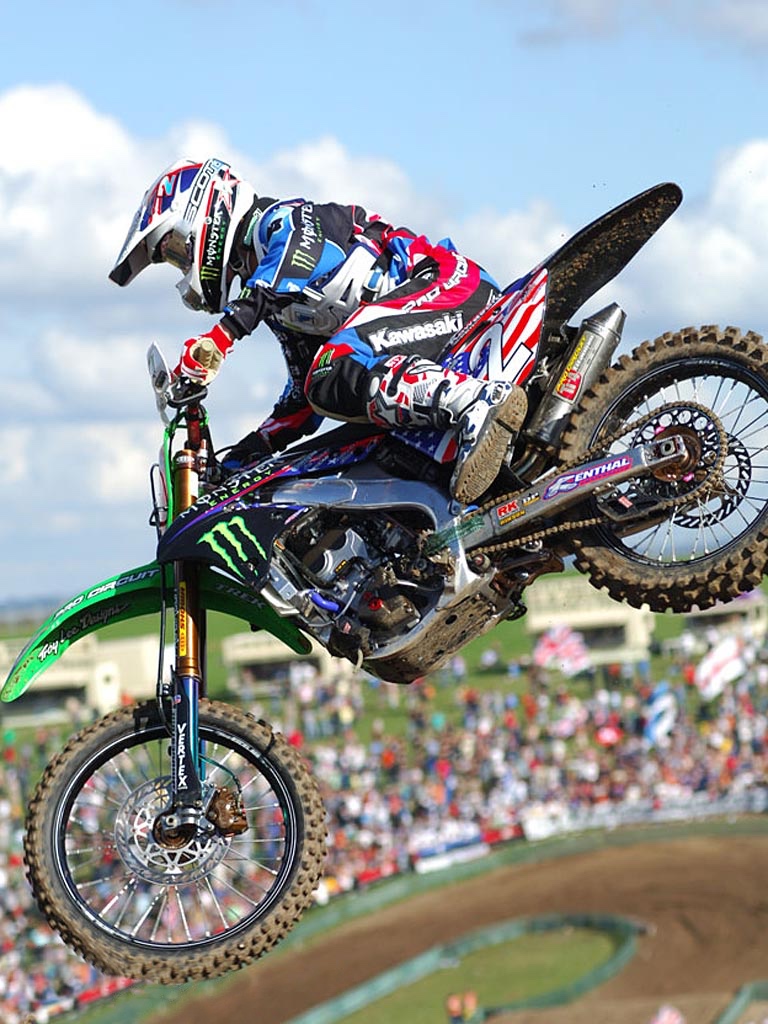 Kawasaki’s secret weapon on the new KX250F in 2006 turned out to be rookie sensation Ryan Villopoto. Relatively unhyped going into the ’06 season, Villopoto dominated the outdoor standings and helped lead Team USA to the 2006 Motocross des Nations title. Photo Credit: Steve Bruhn
Kawasaki’s secret weapon on the new KX250F in 2006 turned out to be rookie sensation Ryan Villopoto. Relatively unhyped going into the ’06 season, Villopoto dominated the outdoor standings and helped lead Team USA to the 2006 Motocross des Nations title. Photo Credit: Steve Bruhn
Of all the upgrades made for 2006, perhaps the most dramatic improvement was in the KX’s handling. Previous KX250Fs had suffered from vague steering and an unbalanced feel that hindered its appeal on the track. A Pro Circuit suspension link and some suspension tuning could make it better, but the first generation KX250F was never in the same handling league as Honda’s excellent CRF250R. For 2006, the KX’s new chassis alleviated most of those handling concerns and transformed the KX250F into one of the best-handling machines in the class. The new bike felt light and cornered far better than in the past. The narrow chassis and excellent ergonomics made the bike very comfortable to ride and the well-sorted suspension assured that the green machine never did anything weird or unexpected. With its excellent cornering, light feel, and solid stability, many riders picked the KX250F as the best overall handling machine in the class, an honor not bestowed on a green 250 machine since the glory days of Jeff Emig.
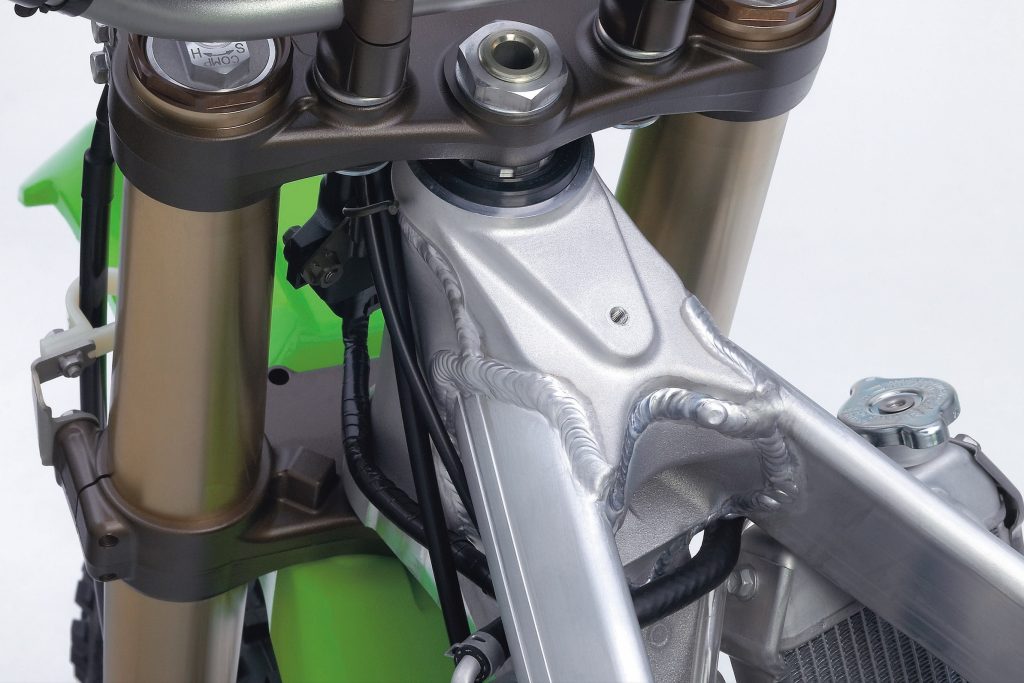 Beautiful craftmanship from the clean alloy welds to the trick bronze coatings on the components helped the KX stand out from the crowd in 2006. Photo Credit: Kawasaki
Beautiful craftmanship from the clean alloy welds to the trick bronze coatings on the components helped the KX stand out from the crowd in 2006. Photo Credit: Kawasaki
On the detailing front the 2006 KX250F was significantly improved across the board. The new frame handled well, looked great, and showed far less wear than the old steel one. The unpainted swingarm finally ended one of the most puzzling quirks in motocross with ugly black scratches being a thing of the past. The new Renthal 7/8 bars looked great in their gray finish, increased rider comfort, and lasted longer than the cheap steel bars found on previous KX machines. Braking power was not as strong as the KTM’s Brembo components, but they worked well and were trouble-free. The new larger radiators alleviated the overheating issues and the KX proved far more reliable than the first-generation machine. The 2006 model’s improved cooling, upgraded components, and increased oil flow seemed to address most of the lingering issues that had scared riders away from the Kawasuki twins the two previous years. The clutch was still suspect if abused, but the updated motor was much more durable overall.
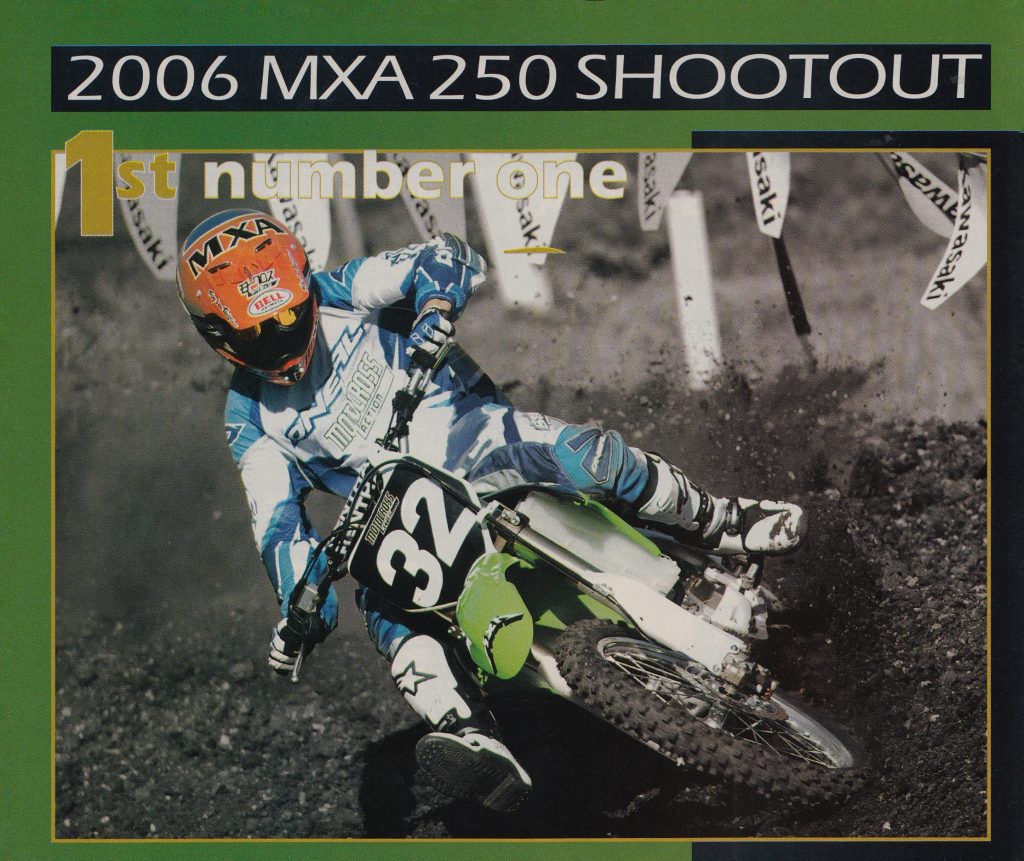 After two years of abuse from the motocross media, Kawasaki’s KX250F came out smelling like a rose in 2006. The KX250F’s victory in MXA’s motocross shootout marked the first time a green 125/250F had taken the crown since 1993. Photo Credit: Motocross Action
After two years of abuse from the motocross media, Kawasaki’s KX250F came out smelling like a rose in 2006. The KX250F’s victory in MXA’s motocross shootout marked the first time a green 125/250F had taken the crown since 1993. Photo Credit: Motocross Action
In the end, the all-new 2006 Kawasaki KX250F proved to be a real winner for Kawasaki. The redesigned machine rectified nearly all the shortcomings of the first generation KX250F and delivered class-leading performance. The updated motor was not a screamer, but its excellent low-to-mid performance made it easy to ride and impressively fast. Its suspension was not quite as supple as the all-new Yamaha’s, but its well-balanced ride and excellent damping performance instilled confidence in the rough. Long a Kawasaki shortcoming, the new KX250F even handled well. It was an excellent all-around package that made going fast easy and finally broke Honda and Yamaha’s stranglehold on the 250 four-stroke division.
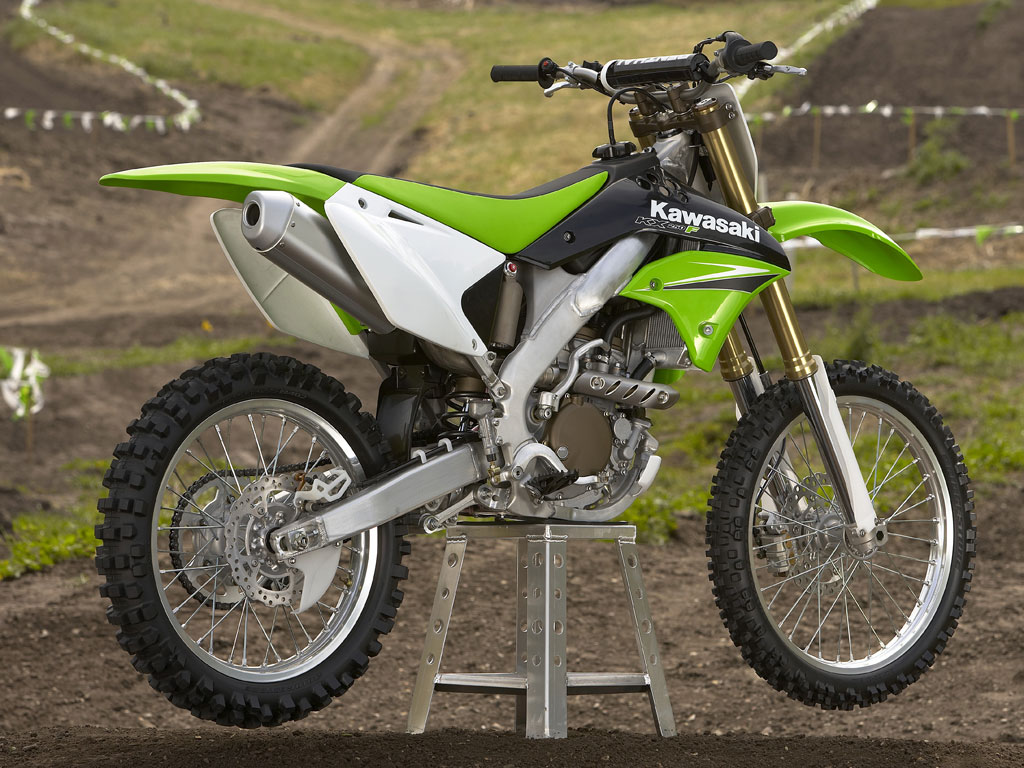 Fast on the track and beautiful to behold, the all-new 2006 KX250F marked a major turning point for Kawasaki’s four-stroke motocross program. Photo Credit: Kawasaki
Fast on the track and beautiful to behold, the all-new 2006 KX250F marked a major turning point for Kawasaki’s four-stroke motocross program. Photo Credit: Kawasaki


